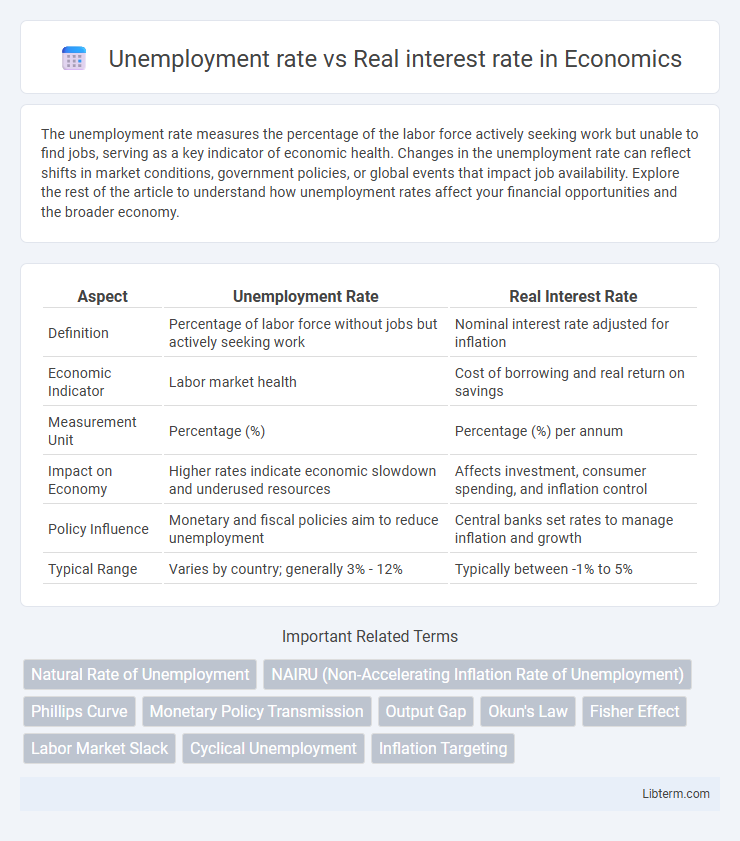The unemployment rate measures the percentage of the labor force actively seeking work but unable to find jobs, serving as a key indicator of economic health. Changes in the unemployment rate can reflect shifts in market conditions, government policies, or global events that impact job availability. Explore the rest of the article to understand how unemployment rates affect your financial opportunities and the broader economy.
Table of Comparison
| Aspect | Unemployment Rate | Real Interest Rate |
|---|---|---|
| Definition | Percentage of labor force without jobs but actively seeking work | Nominal interest rate adjusted for inflation |
| Economic Indicator | Labor market health | Cost of borrowing and real return on savings |
| Measurement Unit | Percentage (%) | Percentage (%) per annum |
| Impact on Economy | Higher rates indicate economic slowdown and underused resources | Affects investment, consumer spending, and inflation control |
| Policy Influence | Monetary and fiscal policies aim to reduce unemployment | Central banks set rates to manage inflation and growth |
| Typical Range | Varies by country; generally 3% - 12% | Typically between -1% to 5% |
Understanding Unemployment Rate and Real Interest Rate
The unemployment rate measures the percentage of the labor force actively seeking but unable to find work, reflecting the health of the job market. The real interest rate, adjusted for inflation, represents the true cost of borrowing and the real yield on savings, influencing consumer spending and investment decisions. Understanding the interaction between unemployment and real interest rates helps policymakers gauge economic conditions and implement strategies to stimulate growth or control inflation.
Historical Trends: Unemployment vs Real Interest Rates
Historical trends reveal an inverse relationship between the unemployment rate and real interest rates, where periods of high unemployment often coincide with lower real interest rates to stimulate economic growth. During economic recessions, central banks typically reduce real interest rates to encourage borrowing and investment, which helps reduce unemployment over time. Conversely, when the economy improves and unemployment rates drop, real interest rates tend to rise to control inflation and prevent overheating.
Economic Theories Linking Unemployment and Interest Rates
Economic theories like the Phillips Curve suggest an inverse relationship between unemployment rate and real interest rate, where lower unemployment often leads to higher inflation and thus higher real interest rates. The Natural Rate Hypothesis argues that unemployment gravitates toward a natural rate unaffected by real interest changes in the long run. Monetary policy frameworks, including the Taylor Rule, adjust real interest rates to stabilize inflation and influence unemployment levels through demand management in the economy.
Monetary Policy Impact on Real Interest Rates and Employment
Monetary policy influences real interest rates by adjusting nominal rates and inflation expectations, which directly affects borrowing costs and investment decisions. Lower real interest rates typically stimulate employment by encouraging businesses to expand and hire more workers, while higher rates may constrain economic growth and increase unemployment. Central banks utilize these mechanisms to stabilize the economy, balancing inflation control with employment objectives.
The Phillips Curve: Relationship Between Inflation, Unemployment, and Rates
The Phillips Curve illustrates an inverse relationship between unemployment and inflation, suggesting that lower unemployment rates often coincide with higher inflation and higher real interest rates set by central banks to control inflationary pressures. Higher real interest rates typically reduce inflation by curbing spending and investment, which can increase unemployment in the short term. Understanding this dynamic helps policymakers balance inflation targeting with employment goals through adjustments in real interest rates.
Case Studies: Countries’ Experiences with Unemployment and Real Interest Rates
Case studies from countries like the United States, Germany, and Japan reveal varied correlations between unemployment rates and real interest rates, influenced by fiscal policies and economic cycles. For instance, during the 2008 financial crisis, the U.S. experienced high unemployment alongside near-zero real interest rates as the Federal Reserve implemented aggressive monetary easing to stimulate growth. Germany's experience with lower unemployment was supported by relatively stable real interest rates, demonstrating the impact of structural labor market reforms combined with prudent monetary policies.
Central Banks' Responses to Rising Unemployment
Central banks often respond to rising unemployment by lowering real interest rates to stimulate economic activity and encourage borrowing and investment. Reducing the real interest rate decreases the cost of credit, spurring business expansion and job creation. Historical data from the Federal Reserve and the European Central Bank show a correlation between interest rate cuts and subsequent declines in unemployment during economic downturns.
How Real Interest Rates Influence Job Creation
Real interest rates directly impact business investment decisions, where lower real rates reduce borrowing costs, encouraging firms to expand operations and create jobs. Higher real interest rates increase the cost of capital, leading to reduced investment and slower job creation. Empirical studies show a negative correlation between real interest rates and employment growth, highlighting their crucial role in labor market dynamics.
Unemployment Rate as a Predictor of Interest Rate Changes
The unemployment rate serves as a critical predictor of real interest rate changes, as lower unemployment typically signals stronger economic growth and potential inflationary pressures, prompting central banks to raise interest rates. Historical data indicate that sustained declines in unemployment rates often precede increases in the real interest rate to temper overheating economies. Monitoring shifts in the unemployment rate provides valuable insights for forecasting central bank policies and real interest rate trends.
Future Outlook: Managing Unemployment Amid Rate Fluctuations
Managing unemployment amid fluctuating real interest rates requires proactive fiscal policies and targeted job creation programs to stabilize labor markets. As central banks adjust rates to control inflation, industries sensitive to borrowing costs may experience varying employment trends, necessitating adaptive workforce development strategies. Future outlooks emphasize the importance of balancing monetary policy with labor market interventions to mitigate unemployment risks in a dynamic economic environment.
Unemployment rate Infographic

 libterm.com
libterm.com